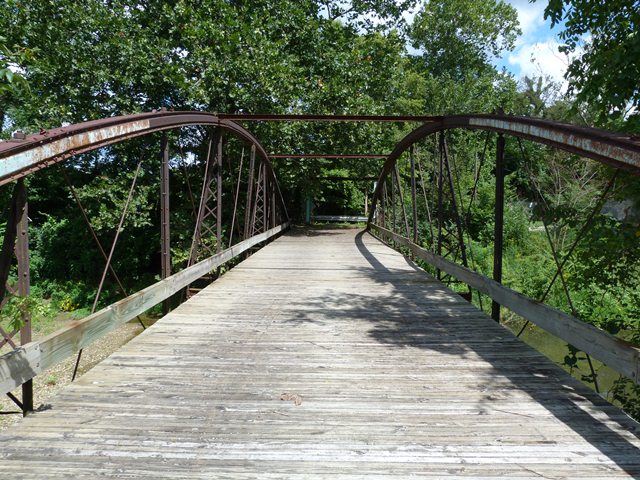We Recommend:
Bach Steel - Experts at historic truss bridge restoration.
BridgeHunter.com Phase 1 is released to the public! - Visit Now
Loren Road Bridge
The Trestle Bridge

Primary Photographer(s): Nathan Holth and Rick McOmber
Bridge Documented: May 21, 2006 and August 12, 2012
Rural (Near Mt. Gilead): Morrow County, Ohio: United States
1879 By Builder/Contractor: Wrought Iron Bridge Company of Canton, Ohio
Not Available or Not Applicable
102.0 Feet (31.1 Meters)
104.0 Feet (31.7 Meters)
14 Feet (4.27 Meters)
1 Main Span(s)
5930197

View Information About HSR Ratings
Bridge Documentation
View Archived National Bridge Inventory Report - Has Additional Details and Evaluation
View Historic American Engineering Record (HAER) Documentation For This Bridge
HAER Drawings, PDF - HAER Data Pages, PDF
This bridge is sometimes called The Trestle Bridge because there was once a railroad bridge that crossed the creek beside this bridge. The bowstring truss bridge is arguably the rarest "once-common" type of bridge in North America. A blend of truss and arch structure types, these bridges were mainly built in the 1870s, and bridge builders experimented with the use of metal in bridge building. As such, with the exception of a few outliers, bowstring truss bridges are among the oldest metal bridges in the country. This rarity does not mean however that appropriate sources of funding are available to restore the few remaining bridges however. Programs like the National Historic Covered Bridge Preservation Act have saved only one structure type, leaving other structure types, regardless of historic significance, to be unfunded and often demolished and replaced.
The fate of the Loren Road Bridge is in question, because it was at the receiving end of a careless driver who collided with and damaged the bridge. Vehicle-bridge collisions occur far too often, most likely because drivers are never penalized appropriately. In this case, the driver's insurance should have been called upon to repair the damages done to this important historic bridge. Drivers need to remember to reduce speed significantly when crossing narrow and historic bridges. Doing so will ensure that control of the vehicle is not lost, and that both bridge and driver remain safe.
The Loren Road Bridge is a rare example of a Wrought Iron bridge Company bowstring truss bridge. Alterations include replacement of much of the flooring system, as well as replacement of the sway bracing. Otherwise, the structure is an excellent example of its type, and is a fairly long example as well.
Information and Findings From Ohio's Historic Bridge InventorySetting/Context The bridge is closed to all traffic due to impact damage from 2005. It is located on a road adjacent to the county yard, fairgrounds, and sewage treatment plant. The road is closed. Physical Description The 1 span, 104'-long, wrought-iron bowstring thru truss bridge has tubular upper chord, built-up verticals, rod diagonals, and lower chord bars. The bridge was strengthened by adding members prior to its closing. Integrity Rehabilitated in 1999. Impact damage caused closure in 2005. Summary of Significance The 1879 bowstring truss is a rare and technologically significant example of a WIBCo patented bowstring truss. The bridge was sensitively rehabilitated in 1999 and has had some impact damage forcing its closure. The eligible recommendation of the prior inventory remains appropriate. It has been documented by HAER OH-59. Justification The bridge is one of the 22 extant bowstring truss bridges that survive in the state. Having so many is remarkable, and even though they are "common" based on their numbers, each is an important and irreplaceable record of the development of the metal truss bridge and the ingenuity associated with the Ohio industrial development. The bridge has high significance. Bridge Considered Historic By Survey: Yes |
This bridge is tagged with the following special condition(s): Keystone Columns
![]()
Photo Galleries and Videos: Loren Road Bridge
2012 Bridge Photo-Documentation
Original / Full Size PhotosA collection of overview and detail photos, taken August 12, 2012. This gallery offers photos in the highest available resolution and file size in a touch-friendly popup viewer.
Alternatively, Browse Without Using Viewer
![]()
2012 Bridge Photo-Documentation
Mobile Optimized PhotosA collection of overview and detail photos, taken August 12, 2012. This gallery features data-friendly, fast-loading photos in a touch-friendly popup viewer.
Alternatively, Browse Without Using Viewer
![]()
2006 Bridge Photo-Documentation
A collection of overview and detail photos, taken May 19, 2006. This photo gallery contains a combination of Original Size photos and Mobile Optimized photos in a touch-friendly popup viewer.Alternatively, Browse Without Using Viewer
![]()
Maps and Links: Loren Road Bridge
Coordinates (Latitude, Longitude):
Search For Additional Bridge Listings:
Bridgehunter.com: View listed bridges within 0.5 miles (0.8 kilometers) of this bridge.
Bridgehunter.com: View listed bridges within 10 miles (16 kilometers) of this bridge.
Additional Maps:
Google Streetview (If Available)
GeoHack (Additional Links and Coordinates)
Apple Maps (Via DuckDuckGo Search)
Apple Maps (Apple devices only)
Android: Open Location In Your Map or GPS App
Flickr Gallery (Find Nearby Photos)
Wikimedia Commons (Find Nearby Photos)
Directions Via Sygic For Android
Directions Via Sygic For iOS and Android Dolphin Browser
USGS National Map (United States Only)
Historical USGS Topo Maps (United States Only)
Historic Aerials (United States Only)
CalTopo Maps (United States Only)



